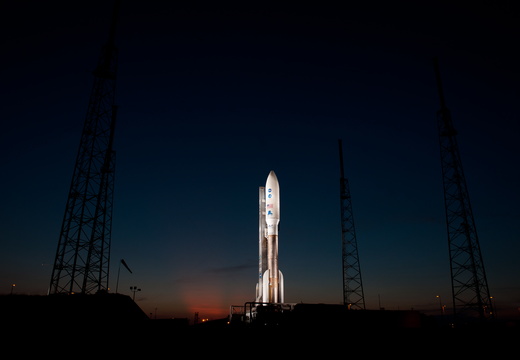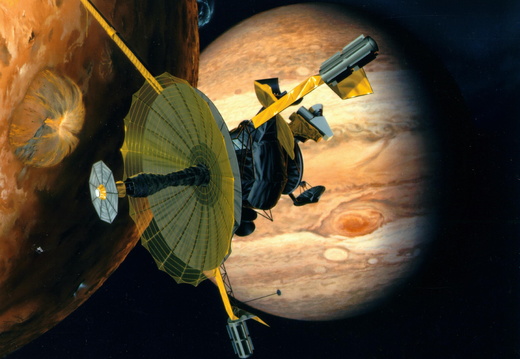
JUNO
On August 5, 2011, NASA’s Juno spacecraft embarked on a 5-year journey to our solar system's largest planet – the gas giant Jupiter. Its mission: to probe beneath the planet's dense clouds and answer questions about the origin and evolution of Jupiter, our solar system, and giant planets in general across the cosmos. Juno arrived at Jupiter on July 4, 2016, after a 5-year, 1.7-billion-mile journey, and settled into a 53-day polar orbit stretching from just above Jupiter’s cloud tops to the outer reaches of the Jovian magnetosphere.
Juno’s discoveries have revolutionized our understanding of Jupiter and solar system formation. During the prime mission’s 35 orbits of Jupiter, Juno collected more than three terabits (375 gigabytes) of science data and provided dazzling views of Jupiter and its satellites, all processed by citizen scientists with NASA’s first-ever camera dedicated to public outreach. Juno’s many discoveries have changed our view of Jupiter’s atmosphere and interior, revealing an atmospheric weather layer that extends far beyond its clouds and a deep interior with a diluted, or "fuzzy," heavy element core. Near the end of the prime mission, as the spacecraft’s orbit evolved, flybys of the moon Ganymede initiated Juno’s transition into a full Jovian system explorer.
Extended Mission
Now in its extended mission, the agency’s most distant planetary orbiter continues its investigation of the solar system’s largest planet through September 2025, or until the spacecraft’s end of life. The extended mission’s science campaigns expand on discoveries Juno has already made about Jupiter’s interior structure, internal magnetic field, atmosphere (including polar cyclones, deep atmosphere, and auroras), and magnetosphere. Jupiter’s enigmatic Great Blue Spot – an isolated patch of intense magnetic field near the planet’s equator – is the target of a high-spatial-resolution magnetic survey during six flybys early in the extended mission.
Juno is now an explorer of the full Jovian system. As the spacecraft's orbit continues to evolve, additional flybys of the moons Europa and Io are planned. Juno will also fly through the Europa torus and the Io torus. These are doughnut-shaped clouds of charged particles that surround each moon's orbit. The spacecraft will pass through the tori on multiple occasions, characterizing the radiation environment near these satellites to better prepare NASA’s Europa Clipper mission and the European Space Agency’s JUICE mission for optimizing observation strategies and planning, science priorities, and mission design. The extended mission also adds a study of dust in Jupiter’s faint rings to Juno’s extensive list of science investigations.
Learn more about Juno at the mission website.
The Giant Planet Story is the Story of the Solar System
Juno's principal goal is to understand the origin and evolution of Jupiter. Underneath its dense cloud cover, Jupiter safeguards secrets to the fundamental processes and conditions that governed our solar system during its formation. As our primary example of a giant planet, Jupiter can also provide critical knowledge for understanding the planetary systems being discovered around other stars.
With its suite of science instruments, Juno has investigated the existence of a solid planetary core, mapped Jupiter's intense magnetic field, measured the amount of water and ammonia in the deep atmosphere, and observed the planet's auroras.
Juno has let us take a giant step forward in our understanding of how giant planets form and the role these titans played in putting together the rest of the solar system.
Jupiter's Origins and Interior
Theories about solar system formation all begin with the collapse of a giant cloud of gas and dust, or nebula, most of which formed the infant Sun. Like the Sun, Jupiter is mostly hydrogen and helium, so it must have formed early, capturing most of the material left after our star came to be. How this happened, however, is unclear. Did a massive planetary core form first and gravitationally capture all that gas, or did an unstable region collapse inside the nebula, triggering the planet's formation? Differences between these scenarios are profound.
Even more importantly, the composition and role of icy planetesimals, or small protoplanets, in planetary formation hangs in the balance – and with them, the origin of Earth and other terrestrial planets. Icy planetesimals likely were the carriers of materials like water and carbon compounds that are the fundamental building blocks of life.
Unlike Earth, Jupiter's giant mass allowed it to hold onto its original composition, providing us with a way of tracing our solar system's history. Juno is measuring the amount of water and ammonia in Jupiter's atmosphere and helping to determine if the planet actually has a solid core, directly resolving the origin of this giant planet and thereby the solar system. By mapping Jupiter's gravitational and magnetic fields, Juno is revealing the planet's interior structure and measuring the planet’s diluted heavy element core.
Atmosphere
How deep Jupiter's colorful zones, belts, and other features penetrate is one of the most fundamental questions about the giant planet. Juno’s observations are helping to determine the global structure and motions of the planet's atmosphere below the cloud tops, mapping variations in the atmosphere's composition, temperature, clouds, and patterns of movement down to unprecedented depths.
Magnetosphere
Deep in Jupiter's atmosphere, under great pressure, hydrogen gas is squeezed into a fluid known as metallic hydrogen. At these great depths, the hydrogen acts like an electrically conducting metal, and this is believed to be the source of the planet's intense magnetic field. This powerful magnetic environment creates the brightest auroras in our solar system, as charged particles precipitate down into the planet's atmosphere. Juno directly samples the charged particles and magnetic fields near Jupiter's poles, while simultaneously observing the auroras in ultraviolet light produced by the extraordinary amounts of energy crashing into the polar regions. These investigations are greatly improving our understanding of this remarkable phenomenon, and also of similar magnetic objects, like young stars with their own planetary systems.
In Greek and Roman mythology, Jupiter drew a veil of clouds around himself to hide his mischief. It was Jupiter's wife, the goddess Juno, who was able to peer through the clouds and reveal Jupiter's true nature. The Juno spacecraft also looks beneath the clouds to see what the planet is up to, not seeking signs of misbehavior, but helping us to understand the planet's structure and history.
Mission Timeline
Juno is the second mission competitively selected under NASA's New Frontiers Program. The program provides opportunities to carry out several medium-class missions identified as top priority objectives in the planetary science decadal survey conducted by the Space Studies Board of the National Research Council in Washington.
JPL manages the Juno mission for the principal investigator, Scott Bolton, of the Southwest Research Institute in San Antonio. The New Frontiers Program managed at NASA's Marshall Space Flight Center in Huntsville, Ala. Lockheed Martin Space Systems, Denver, built and operates the spacecraft.
About Jupiter ›
